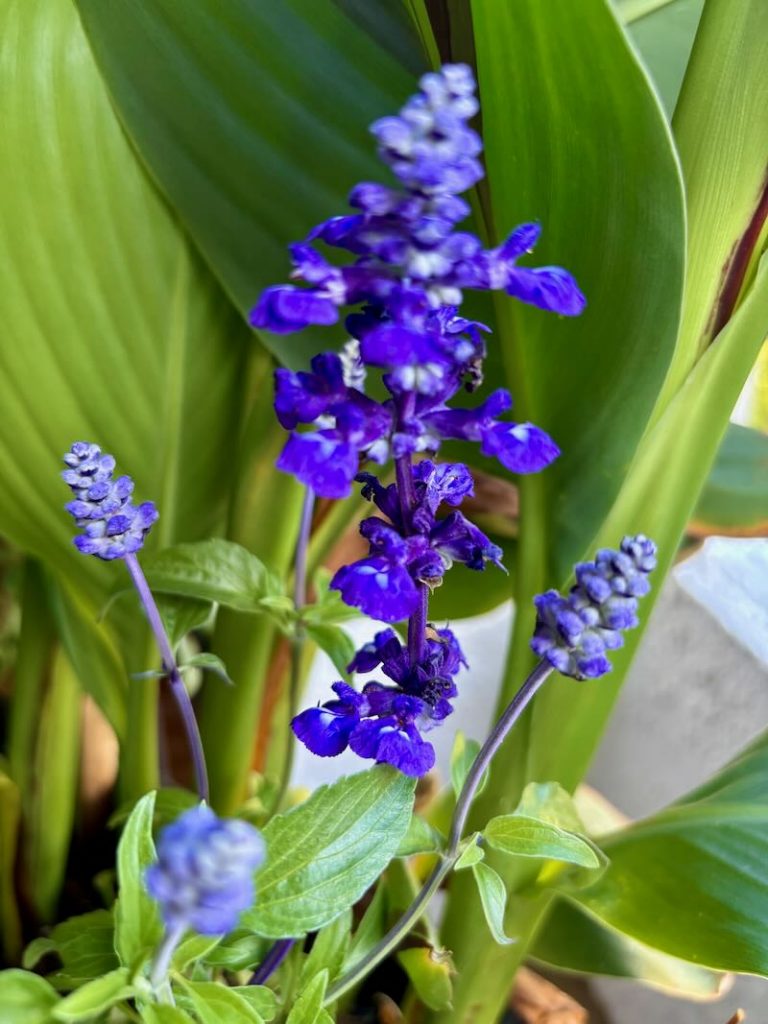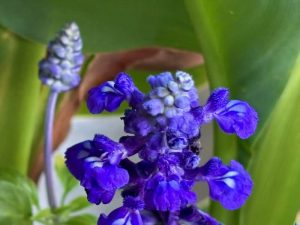Salvia farinacea ‘Victoria™ Blue’: A Reliable Garden Performer
Salvia farinacea ‘Victoria™ Blue’, often called Mealy Sage, has earned a reputation as one of the most rewarding plants for summer gardens. This compact, upright cultivar delivers a striking display of violet-blue flower spikes from late spring until the first frost. Gardeners prize it not only for its vivid color but also for its ability to attract pollinators such as bees, butterflies, and hummingbirds. Belonging to the Mint family, Lamiaceae, this plant offers a fragrant presence, strong garden performance, and adaptability that appeals to both beginner and seasoned gardeners.
Native to Texas and Mexico, Salvia farinacea naturally thrives in sunny, dry conditions, and breeders developed ‘Victoria Blue’ to emphasize vigor, weather resistance, and ornamental appeal. Mealy Sage with its narrow, aromatic leaves and densely packed flower spikes, it provides a vertical accent that resembles lavender, yet requires less fuss. Its tolerance to heat, drought, and poor soils, combined with resistance to deer and rabbits, makes it an excellent choice for low-maintenance and eco-friendly gardens.
Salvia farinacea ‘Victoria™ Blue’ traces its origins to dedicated breeding programs that shaped its compact form and vibrant blue bloom. This cultivar was developed by Benary Seeds, a respected German seed company, and was also introduced widely by Ball Horticultural Company, which ensured its consistent performance in garden settings. Their careful selection focused on strong branching, rich color, and resilient growth — traits that have made ‘Victoria™ Blue’ a long-lasting favorite among gardeners and landscapers.
The Appeal of Salvia farinacea ‘Victoria™ Blue’
Gardeners often choose ‘Victoria™ Blue’ because it offers a unique combination of beauty and resilience. While many annuals fade by midsummer, this variety continues producing fresh spikes of royal blue flowers right up to frost. Each bloom emerges from a calyx with a white, powdery coating, the trait that gave rise to the common name Mealycup Sage. When planted in drifts, the intense color draws the eye across a border, yet the compact growth habit also makes it ideal for containers or smaller spaces.
The plant grows to a height of 45–60 cm (18–24 in.) and spreads about 40 cm (16 in.), forming dense, upright clumps. Its medium texture allows it to blend well with perennials and shrubs, while still standing out as a feature in beds or pollinator gardens. Cut stems hold well in vases, and the dried flower spikes retain their form and color, making them useful for floral crafts and dried arrangements.
Flowers and Foliage of Mealy Sage
The most celebrated feature of ‘Victoria™ Blue’ is, of course, its flowers. Each spike measures about 20–25 cm (8–10 in.) and carries dozens of small, tubular blossoms in deep violet-blue. These flowers open sequentially, ensuring a long display from each stem. Because the flowers rise above the foliage, the plant creates a layered effect that adds dimension to plantings.
The foliage also contributes to its charm. Narrow, lance-shaped leaves line the stems and release a subtle fragrance when brushed. Their gray-green color provides a neutral backdrop that allows the brilliant flowers to shine. The mealy coating on the calyces and stems gives a silvery sheen that enhances texture in the garden. Together, the flowers and foliage create a plant that looks fresh and vibrant for months.
Seasonal Performance and Blooming Habit
Salvia ‘Victoria Blue’ begins flowering in late spring or early summer, depending on local climate. In regions with mild winters, it can bloom nearly year-round, but in most temperate zones, the display continues until frost. Unlike some annuals that need constant feeding or pinching, this variety keeps blooming with only modest care. Regular deadheading stimulates even more flower production, extending the show deep into autumn.
As a tender perennial, it survives in USDA Hardiness Zones 8 to 10, where it may persist for several years. In cooler climates, gardeners grow it as an annual, replanting each spring. Despite this, its rapid growth and generous flowering habit make it a rewarding choice for seasonal displays.
Landscape Uses for Salvia ‘Victoria™ Blue’
The versatility of Mealy Sage allows gardeners to use it in many settings. In cottage gardens, it fits naturally among roses, coneflowers, and daisies, where its blue tones balance warmer pinks and yellows. In modern landscapes, it provides clean vertical lines that contrast with grasses or low groundcovers. Mass plantings along walkways or driveways create bold swaths of color, while containers on patios or balconies offer a portable burst of blue.
Because it attracts pollinators, it also works beautifully in wildlife gardens. Bees, butterflies, and hummingbirds all flock to the blossoms, creating an active, vibrant space. The fact that deer and rabbits typically ignore it makes it even more useful in areas where browsing pests pose a challenge.
How to Grow Salvia farinacea ‘Victoria™ Blue’
Light
Plant Salvia ‘Victoria™ Blue’ in full sun for the best results. It requires at least six hours of direct sunlight per day to produce abundant flowers and maintain compact growth. In partial shade, it may survive, but the stems tend to stretch and blooms appear less profuse.
Soil
Provide well-drained soil, whether sandy, loamy, or a mix. Although this variety tolerates poor soils, it performs best in moderately fertile ground. Standing water quickly causes root rot, so drainage is more important than richness. If planting in heavy clay, amend with compost and coarse sand to improve aeration.
Watering
Water thoroughly after planting and keep the soil evenly moist until roots establish. Once mature, Salvia ‘Victoria Blue’ tolerates drought and requires only occasional watering during dry spells. In containers, check soil moisture more often, as pots dry out faster in hot weather. Always allow the soil surface to dry between waterings to prevent fungal problems.
Fertilizing
Feed Mealy Sage lightly at planting with a balanced, slow-release fertilizer. Too much nitrogen encourages leafy growth at the expense of flowers, so avoid heavy feeding. A midseason application can encourage a second flush of spikes and sustain bloom production until frost.
Pruning and Deadheading Salvia farinacea ‘Victoria™ Blue’
Remove spent flower spikes regularly by cutting just above a set of leaves. This practice encourages the plant to redirect energy into new blossoms rather than seed production. At the end of the season, or after a heavy flush of bloom, cut the stems back by half to maintain a tidy, compact form. In frost-free zones, pruning in autumn prepares the plant for continued growth in the next season.
Climate and Hardiness
In USDA Zones 8–10, ‘Victoria™ Blue’ behaves as a perennial, surviving mild winters and resuming growth in spring. In cooler zones, it functions as an annual, yet still delivers months of performance. To overwinter plants in colder climates, dig up and pot specimens in autumn, placing them in a sunny indoor window until spring.
Propagation of Mealy Sage
Gardeners can propagate Salvia farinacea ‘Victoria™ Blue’ or Mealy Sage by seed or cuttings. Seeds started indoors 10–12 weeks before the last frost germinate reliably, especially when kept warm at about 20°C (68°F). Transplant seedlings outdoors after the danger of frost passes, spacing them 35–40 cm (14–16 in.) apart.
Cuttings taken from non-flowering stems in late spring also root readily in moist, sterile soil. This method ensures new plants remain identical to the parent, preserving the cultivar’s uniform color and form. Whether by seed or cutting, propagation offers an economical way to fill a garden with this vibrant variety.
Pests and Diseases
One reason gardeners love Salvia ‘Victoria™ Blue’ is its resistance to most common pests and diseases. Its aromatic foliage deters deer and rabbits, while its sturdy stems stand up well to wind and weather. Occasionally, aphids or whiteflies may appear, especially in crowded plantings, but a blast of water or application of insecticidal soap usually controls them. Powdery mildew may develop in humid conditions with poor air circulation, so spacing plants properly helps prevent problems. Overall, this cultivar requires minimal intervention to remain healthy and productive.
Why Gardeners Choose Salvia ‘Victoria™ Blue’
The enduring popularity of Mealy Sage comes from more than just its looks. Gardeners appreciate a plant that provides continuous color, supports pollinators, and withstands challenges with ease. Its long season of bloom, tolerance to heat and drought, and resistance to browsing animals make it dependable. At the same time, its adaptability to containers and borders ensures it fits a wide range of garden designs.
Salvia farinacea ‘Victoria™ Blue’ represents the best qualities of modern ornamental breeding: performance, beauty, and resilience. For gardeners seeking a low-maintenance, high-impact plant, it offers everything needed to brighten outdoor spaces from spring through frost.



